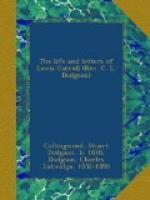As the “Notes of an Oxford Chiel” has been long out of print, I will give a few more extracts from this paper:—
On Differentiation.
The effect of Differentiation on a Particle is very remarkable, the first differential being frequently of greater value than the original particle, and the second of less enlightenment.
For example, let L = “Leader”, S = “Saturday”, and then LS = “Leader in the Saturday” (a particle of no assignable value). Differentiating once, we get L.S.D., a function of great value. Similarly it will be found that, by taking the second Differential of an enlightened Particle (i.e., raising it to the Degree D.D.), the enlightenment becomes rapidly less. The effect is much increased by the addition of a C: in this case the enlightenment often vanishes altogether, and the Particle becomes Conservative.
PROPOSITIONS.
PROP. I. PR.
To find the value of a given Examiner.
Example.—A takes in ten books in the Final Examination and gets a 3rd class; B takes in the Examiners, and gets a 2nd. Find the value of the Examiners in terms of books. Find also their value in terms in which no Examination is held.
PROP. II. PR.
To estimate Profit and Loss.
Example.—Given a Derby Prophet, who has sent three different winners to three different betting-men, and given that none of the three horses are placed. Find the total loss incurred by the three men (a) in money, (b) in temper. Find also the Prophet. Is this latter usually possible?
PROP. IV. TH.
The end (i.e., “the
product of the extremes”)
justifies (i.e., “is
equal to”—see Latin
“aequus”) the
means.
No example is appended to
this Proposition, for obvious
reasons.
PROP. V. PR.
To continue a given series.
Example.—A and B, who are respectively addicted to Fours and Fives, occupy the same set of rooms, which is always at Sixes and Sevens. Find the probable amount of reading done by A and B while the Eights are on.
The third paper was entitled “Facts, Figures, and Fancies.” The best thing in it was a parody on “The Deserted Village,” from which an extract will be found in a later chapter. There was also a letter to the Senior Censor of Christ Church, in burlesque of a similar letter in which the Professor of Physics met an offer of the Clarendon Trustees by a detailed enumeration of the requirements in his own department of Natural Science. Mr. Dodgson’s letter deals with the imaginary requirements of the Mathematical school:—




